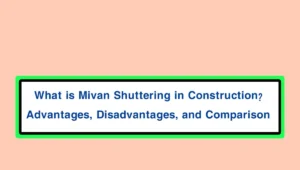What is Mivan Shuttering in Construction? Advantages, Disadvantages, and Comparison.
Mivan shuttering, also known as Mivan formwork, is a revolutionary construction technology that has significantly transformed how large-scale residential and commercial structures are built. Known for its speed, precision, and quality, Mivan shuttering is increasingly being adopted in India and other developing countries where rapid urban housing development is a priority.
In this post, we will explain what Mivan shuttering is, how it works, its advantages and disadvantages, and how it compares to traditional formwork systems.
What is Mivan Shuttering in Construction? Advantages, Disadvantages, and Comparison.
What is Mivan Shuttering?
Mivan shuttering is an aluminium formwork system that is used to construct walls, slabs, columns, beams, and staircases in one continuous pour of concrete. It was developed by a European company called Mivan Company Ltd and became popular for use in mass housing and high-rise projects.
Unlike traditional shuttering (which uses wood or steel), Mivan shuttering is made of lightweight, durable aluminium panels, which can be assembled and reused multiple times.
Components of Mivan Formwork
Mivan shuttering consists of several key components:
- Wall Panels – For vertical surfaces.
- Deck Panels – For slab/forming horizontal surfaces.
- Beam Side and Bottom Panels
- Soffit Length and Soffit Corner
- Prop Head and Panel Props – For support.
- Pins and Wedges – For joining and locking panels.
- Aluminium form ties – Maintain the distance between walls.
Construction Process Using Mivan Shuttering
- Plumbing and Electrical Conduits: Services are laid out before shuttering.
- Formwork Assembly: Aluminium panels are assembled on-site.
- Steel Reinforcement: Placed within the formwork.
- Concrete Pouring: A single pour is done for walls, slabs, and columns.
- De-shuttering: After the concrete sets (12–24 hours), the formwork is removed.
This process is quick, accurate, and significantly reduces human error.
✅ Advantages of Mivan Shuttering
- Speed of Construction: Ideal for mass housing and repetitive layouts.
- Quality Finish: Smooth and uniform surfaces that reduce plastering.
- Durability: Aluminium panels can be reused up to 200 times
- Precision: Ensures dimensional accuracy and consistent output.
- Less Skilled Labor: Easier to assemble compared to traditional wood formwork.
- Integrated Work: Simultaneous casting of walls and slabs.
❌ Disadvantages of Mivan Shuttering
- High Initial Cost: The aluminium system is expensive to purchase.
- Less Flexibility: Not ideal for complex architectural designs.
- Joint Marks: Can be visible if finishing is not properly done.
- Special Handling: Requires training and careful handling to avoid panel damage.
- Not Suitable for Small Projects: Economical only when used on large-scale projects.
🆚 Mivan Shuttering vs Traditional Formwork
| Feature | Mivan Shuttering | Traditional Shuttering |
|---|---|---|
| Material | Aluminium | Timber/Steel |
| Reusability | Up to 200 times | 20–30 times |
| Surface Finish | Smooth, no plaster required | Needs plastering |
| Speed | Very fast | Slower |
| Cost | High initial investment | Low initial investment |
| Labor | Less skilled labor needed | More labor-intensive |
| Best For | Mass housing, high-rise buildings | Small or customized projects |
Applications of Mivan Shuttering
- Government housing schemes (e.g., PMAY)
- High-rise apartments
- Mass residential townships
- Student hostels and dormitories
- Infrastructure projects needing speed
Mivan Technology in India
India’s urban housing needs have made Mivan technology increasingly popular in cities like Delhi, Mumbai, Pune, Hyderabad, and Bangalore. Major developers and government agencies are using it for rapid delivery and consistent quality.
Conclusion
Mivan shuttering has emerged as a game-changing solution in modern construction. Its speed, accuracy, and smooth finish make it perfect for large-scale residential or governmental projects. While it may not suit every project due to cost and design constraints, the advantages of Mivan technology are hard to overlook when time and quality are critical.
❓ FAQs about Mivan Shuttering
1. What is Mivan shuttering used for?
A1. Mivan shuttering is used for fast construction of walls, slabs, and columns, mainly in mass housing and high-rise buildings.
2. How many times can Mivan shuttering be reused?
A2. It can be reused around 150–200 times with proper care and handling.
3. Is Mivan formwork cost-effective?
A3. It has a high initial cost but becomes cost-effective in large-scale repetitive projects due to speed and reusability.
4. Can Mivan shuttering be used for small buildings?
A4. It’s not economical for small or custom-designed structures.
5. What kind of surface finish does Mivan shuttering provide?
A5. It provides a smooth, uniform finish that often eliminates the need for plastering.
6. Does Mivan require skilled labor?
A6. No, Mivan shuttering can be assembled easily and doesn’t require highly skilled labor.
7. What are the disadvantages of Mivan technology?
A7. High cost, less design flexibility, and visible joint lines are some disadvantages.
Home Page: Click Here

